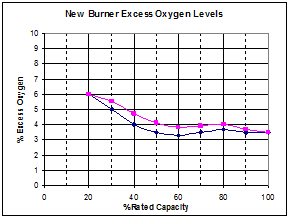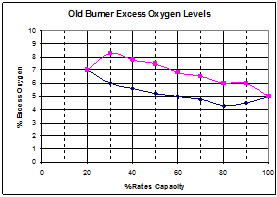Retrofit Boiler Burner - Efficiency Savings Payback
Boiler burner retrofits are often done for several reasons. Historically, the poor reliability and high maintenance cost of an older burner justifies the replacement. Today, with the rising fuel costs, the improvements in efficiency can justify the replacements for newer burners. This report will look at ways to identify those efficiency savings.
 Replacing an older burner, even with the same controls will automatically improve the boiler operating efficiency. As the burner operates, the linkage and valves wear and over time, create some gaps in the linkage connections. Fuel pressure regulating valves (both gas and oil) tend to have larger pressure fluctuations as they wear, and have more internal friction. All of these changes result in less accurate fuel-air-ratio control. Even in a new burner with excellent controls, there is some Hysteresis in the system. This hysteresis is the difference between the excess air (or oxygen) level of the burner when modulating up in rate compared to the excess air (or oxygen) level when the burner is modulating down in rate. The following chart shows a typical new linkage burner excess air level modulating up and down in rate.
Replacing an older burner, even with the same controls will automatically improve the boiler operating efficiency. As the burner operates, the linkage and valves wear and over time, create some gaps in the linkage connections. Fuel pressure regulating valves (both gas and oil) tend to have larger pressure fluctuations as they wear, and have more internal friction. All of these changes result in less accurate fuel-air-ratio control. Even in a new burner with excellent controls, there is some Hysteresis in the system. This hysteresis is the difference between the excess air (or oxygen) level of the burner when modulating up in rate compared to the excess air (or oxygen) level when the burner is modulating down in rate. The following chart shows a typical new linkage burner excess air level modulating up and down in rate.
There is usually a ½% to 1% difference in excess oxygen levels in a new burner. Most of this is due to the gas or oil pressure regulator. You will also see some uneven results in the curve from low to high fire. This can occur because of the way the valves operate, or the difference in hysteresis at different firing rates. The pressure regulators have much less hysteresis at high rates, and the play in the linkage is less critical at higher rates.
 The next chart looks at the same burner after it has been in operation for a number of years. The wear on the linkage and control valves is apparent in the gap between the up and down modulation. It has changed from about ½% to 2% in excess oxygen. This increased difference in excess oxygen directly results in lower efficiency. Another difference that shows on the curve is that the general levels of excess oxygen have increased, reflecting the deterioration of the firing head, and that it needs higher excess air levels to prevent high levels of unburned fuel (CO or smoke). These would include broken and cracked refractory, worn oil and gas nozzles and deformed air handling vanes. All of these components are exposed to the high temperature flame, and will deteriorate over time.
The next chart looks at the same burner after it has been in operation for a number of years. The wear on the linkage and control valves is apparent in the gap between the up and down modulation. It has changed from about ½% to 2% in excess oxygen. This increased difference in excess oxygen directly results in lower efficiency. Another difference that shows on the curve is that the general levels of excess oxygen have increased, reflecting the deterioration of the firing head, and that it needs higher excess air levels to prevent high levels of unburned fuel (CO or smoke). These would include broken and cracked refractory, worn oil and gas nozzles and deformed air handling vanes. All of these components are exposed to the high temperature flame, and will deteriorate over time.
The calculation of efficiency will use the average of the two excess oxygen rates (from an increasing and decreasing firing rate), since they should spend an equal time at each level. The result of the “Old” and “New” retrofit burner excess air levels are shown below. The difference between these lines represents the additional air used by the old burner, and the heat it contains is lost to the environment, reducing the efficiency.
Learn how Webster's new JBE(X) high turndown boiler can improve efficiency.
 In addition, a line representing a Parallel Positioning Control (or linkageless control) is also shown. The Parallel Positioning Control uses individual actuators with an electronic control to determine the best position of fuel and air. It can provide the best match of fuel, air and other settings (register, atomizing air and FGR rate) for each firing rate, where a linkage control has limited adjustment capability. The advantage of the Parallel Positioning Control is more obvious when used with multiple fuels, high turndown and low emissions.
In addition, a line representing a Parallel Positioning Control (or linkageless control) is also shown. The Parallel Positioning Control uses individual actuators with an electronic control to determine the best position of fuel and air. It can provide the best match of fuel, air and other settings (register, atomizing air and FGR rate) for each firing rate, where a linkage control has limited adjustment capability. The advantage of the Parallel Positioning Control is more obvious when used with multiple fuels, high turndown and low emissions.
A side effect of the reduction in excess air is the reduction in stack temperature. Increasing the excess air reduces the flame temperature because the added cold air lowers the mixed temperature. This lower flame temperature reduces the radiant heat transfer in the furnace, increasing the stack temperature. The amount of difference is usually much lower in a Firetube boiler because it is can recover most of this heat in the large convection pass.
The chart below shows several examples of fuel savings with process and heating loads. Variables like stack temperature, hours and days of operation and firing rate have a large impact on the potential savings from a retrofit project. It is important to remember that these are not the only savings available from a retrofit project, but they do represent a specific area of savings that can be used in part to justify the project.



